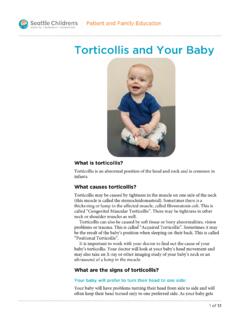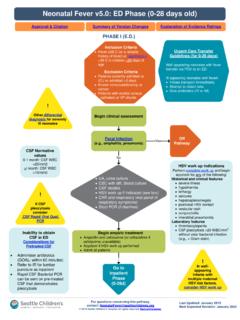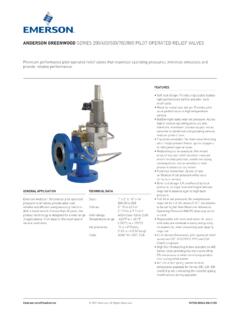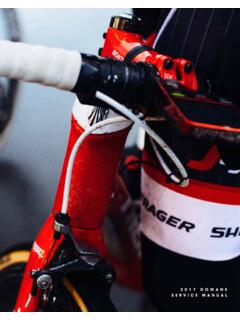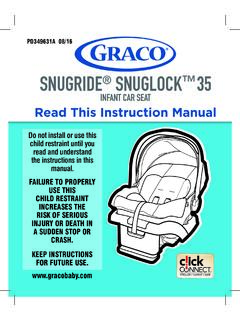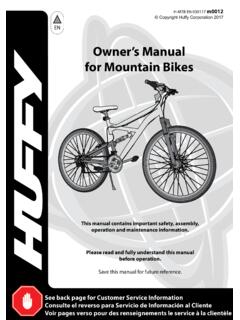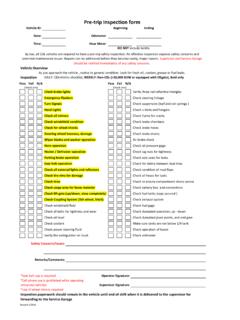Transcription of Torticollis and Your Baby
1 Patient and Family Education 1 of 13 Torticollis and Your Baby What is Torticollis ? Torticollis is an abnormal position of the head and neck and is common in infants. What causes Torticollis ? Torticollis may be caused by tightness in the muscle on one side of the neck (this muscle is called the sternocleidomastoid). Sometimes there is a thickening or lump in the affected muscle, called fibromatosis coli. This is called Congenital Muscular Torticollis . There may be tightness in other neck or shoulder muscles as well. Torticollis can also be caused by soft tissue or bony abnormalities, vision problems or trauma. This is called Acquired Torticollis . Sometimes it may be the result of the baby s position when sleeping on their back. This is called Positional Torticollis . It is important to work with your doctor to find out the cause of your baby s Torticollis .
2 Your doctor will look at your baby s head movement and may also take an X-ray or other imaging study of your baby s neck or an ultrasound of a lump in the muscle. What are the signs of Torticollis ? Your baby will prefer to turn their head to one side: Your baby will have problems turning their head from side to side and will often keep their head turned only to one preferred side. As your baby gets Torticollis and Your Baby 2 of 13 older, they may be able to look straight ahead, but have problems turning their head to the other side. Your baby may tilt their head to one side: Your baby may hold their head tilted to one side with one ear closer to their shoulder. You may see this most when your baby is in a car seat or in photos. Your baby s head may be misshaped: Your baby may have a flattening or bulging on the back or side of the head. This is called plagiocephaly.
3 You may notice one ear is forward of the other ear. Muscle tightness may also change the shape of your baby s facial features on one side of the face. For example, their cheek may appear fuller on one side, or their eye may be more open in appearance compared to the other side. Your baby may open their mouth with an uneven jaw. Behavior: Your baby may become fussy when you try to change the position of their head or when they are put on their tummy because they are not able to lift or turn their head. How is Torticollis treated? The affected muscle in your baby s neck may be shortened, tight and strong, the muscles on the other side of their neck may be stretched and weak. Our goals are to help you position your baby in midline, stretch the tight neck muscles and strengthen the weaker neck muscles. Three main things influence good outcomes in babies with Torticollis : These are: How severe the Torticollis is How old your baby is when you start treatment How well you follow through on your home exercise program What can I do to help treat my baby s Torticollis ?
4 Torticollis is treated through exercises that you do at home with your baby. A good way to work on the exercises is do a different one with each diaper change. That way you are working on them throughout your day. There are 4 main areas that you will work on with your baby. They are: Positioning Stretching Strengthening Motor development Torticollis and Your Baby 3 of 13 Positioning Exercises You can start right away by helping position your baby s head, neck and trunk in a more neutral position. You will also do activities to help promote them turning their head to their non-preferred side. Positioning tips Look at your baby s head position throughout the day. Your baby prefers to turn to their: Right Left Help your baby to keep their head in a straight position that is in line with their body (this is called mid-line ). Move items of interest and change your baby s position to promote them turning their head toward their Right Left.
5 Positioning for birth to 3 months 1. In the car seat, swing or bouncy seat Place firmly rolled thin blankets or towels along your baby s sides. The towel rolls should support the sides of your baby s body and head. Do not place the roll behind your baby or inside the harness in the car seat. This can also be done when your baby is playing on their back to keep their head in midline. Torticollis and Your Baby 4 of 13 2. Position your baby s head to their non-preferred side When carrying your baby in a wrap, carrier or at your shoulder, position their head to their non-preferred side Right Left. This takes pressure off their head to prevent more flattening of the skull. Place your baby so they will turn to their non-preferred side to look at you when you put them in the crib or during diaper changes. Put toys, mobiles and other interesting objects to the non-preferred side of the crib or changing table.
6 3. Positioning for play time P ut your baby lying on either side for play time. You may need to put a rolled towel behind them to keep them from rolling onto their back. You can also place a small folded washcloth under your baby s head to keep their head and neck in line with their trunk. 4. Positioning for feeding When feeding your baby, notice the position of their head, neck and trunk. Try to hold your baby so that their head and body is in a straight position or the head is turned to their Right Left. Torticollis and Your Baby 5 of 13 Help your baby to turn their head by using the rooting reflex. Before feeding, stroke the side of your baby s Right Left cheek to promote head turning or rooting. Repeat this 3 to 4 times before feeding your baby. Do this when you offer a pacifier as well. If your baby is having trouble latching to breast or bottle due to an uneven jaw, talk to your therapist for ideas to help improve their latch.
7 Positioning for 3 to 6 months As your baby gets older, they should spend as much time as possible lying on their tummy. Use a B oppy type pillow, rolled towel or foam wedge if it is still hard for your baby to lift their head. This helps them tolerate this position longer. Keep putting your baby s crib, infant seat, swing, or bouncy chair in the room so your baby needs to turn their head to their Right Left to watch you and other family members. When your baby can sit with support at the waist (or trunk), use a Boppy type pillow, high chair, or hook-on table chair for short periods of time. Use towel rolls along the side of your baby s legs and body for extra support when they are in supporting sitting. Exersaucers and stationary jumpers should be used only in moderation and with supervision. Do not use walkers with wheels. Sitting upright and spending time off of their back takes the pressure off your baby s head and helps it to become more round.
8 Positioning for 6 to 12 months As your baby becomes more active and mobile, be sure they spend time on the floor playing while sitting or lying on their tummy. Support your baby in sitting if needed. When your baby is on the floor, continue to place toys or family activity on their Right Left side. Place a rolled towel under the arm pits. Torticollis and Your Baby 6 of 13 Stretching Exercises Passive range of motion (gentle stretches) may help your baby achieve full neck motion. You can start doing these stretches right away. Stretching tips Work gently within your baby s tolerance. Slowly increase the motion over time. Find the position and time of day that works best for your baby. Hold these gentle stretches for about 30 seconds. Stop the stretch sooner if your baby starts to resist the motion or becomes fussy. You should never feel like you are forcing the motion.
9 You can hold the stretch up to 1 minute if your baby is very relaxed. Use your voice or favorite toys to distract and soothe your baby. Repeat these stretches often during the day: during playtime, after bath and or at each diaper change. 1. Neck rotation stretch: Place your baby on their back. With one hand, gently hold their Right Left shoulder against the surface. Place your open palm gently on your baby s cheek. Slowly help your baby turn their head to their Right Left side. You can also work on this by rolling your baby s body to their Right Left side, gently holding their cheek with one hand and allowing their shoulder to roll back to the surface. You can also do these stretches with your baby on your tummy, lap and propped on your legs. Torticollis and Your Baby 7 of 13 2. Neck rotation stretch on tummy: Place your baby on their stomach, gently guide and turn their head to their Right Left side.
10 3. Neck rotation stretch sit ting on your lap: Hold your baby on your lap. Encourage them to look to their non-preferred side. Gently hold their Right Left shoulder and guide their head to their Right Left side. 4. Neck rotation stretch propped on your legs: With one hand gently hold their Right Left shoulder against the surface of your lap. Place your open palm gently on your baby s cheek. Slowly help your baby turn their head to their Right Left side. Torticollis and Your Baby 8 of 13 5. Lateral head tilt stretch: Place your baby on their back. Use one hand to gently hold your baby s Right Left shoulder against the surface. Place your other hand under your baby s head. Slowly bring their Right Left ear towards their Right Left shoulder. You can try this alternate hand position: Some babies become fussy with this exercise after a while.




